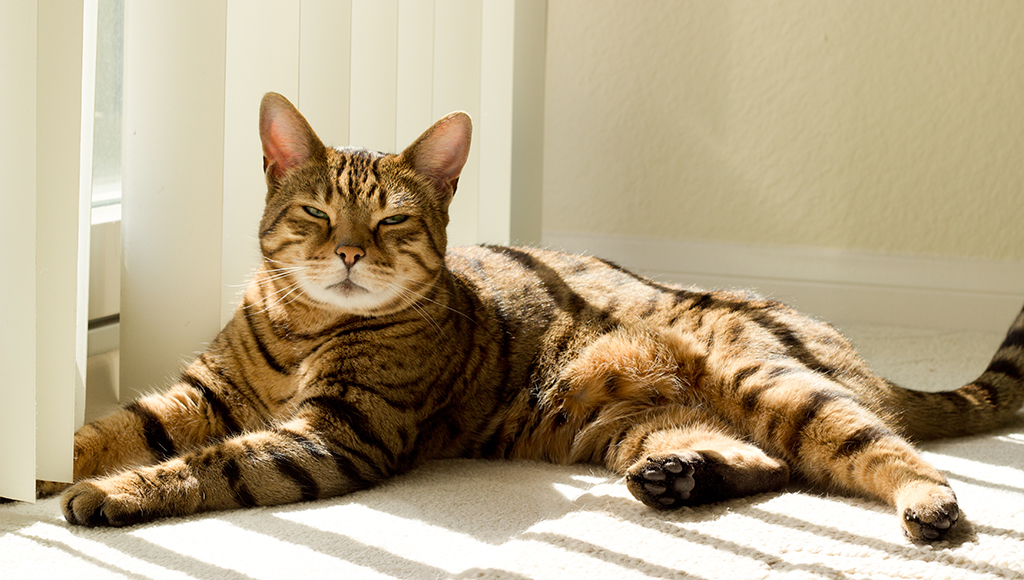Glaucoma in Cats: Signs and Treatment
Here is some helpful information on this devastating and debilitating disease.

A cats' normal vision is superior to humans, but they are also susceptible to many of the conditions that affect our vision. If left untreated, cataracts (opacity of the lens) can lead to glaucoma. Cataracts are rarer in cats than in dogs; so if cataracts are found, it’s important to find and treat the underlying cause. Surgery to remove the affected lens is possible with eligible cats, and lens implants are sometimes used to approximate normal vision.
What is Glaucoma?
Glaucoma is increased pressure within the eye. Cells inside the eye produce aqueous humor, a clear fluid, which maintains the shape of the eye and nourishes the tissues inside the eye. The balance of fluid production and drainage is responsible for maintaining normal pressure within the eye. With glaucoma, the drain becomes clogged and the eye keeps producing fluid. Therefore, the pressure in the eye increases, and can cause the eye to stretch and enlarge, as well as blind the eye.
Primary glaucoma in most cats usually begins in one eye, but it eventually involves both eyes and leads to complete blindness. Secondary Glaucoma occurs when other eye diseases cause decreased fluid drainage. Common causes of secondary glaucoma are uveitis (inflammation inside the eye), advanced cataracts, cancer in the eye, lens subluxation or luxation, and chronic retinal detachment. Glaucoma in cats is usually secondary to chronic inflammation of the uveal tract (uveitis), which is the pigmented, vascular part of the eye. Determining if your cat has primary or secondary glaucoma is important because the treatment needed and the prognosis for vision is different for each type.
How do I know if my cat has Glaucoma?
The only way to verify that your cat has glaucoma is to have the intraocular pressures measured by a veterinarian. Signs of glaucoma can include a red or bloodshot eye and/or a cloudy cornea; vision loss is also characteristic of glaucoma. However, loss of vision in one eye is often not obvious because animals compensate with their remaining eye. Eventually, the increased pressure will cause the eye to stretch and become enlarged. Unfortunately, eyes are usually permanently blind by the time they become enlarged.
How is glaucoma treated?
Since glaucoma occurs when fluid is not draining from the eye fast enough, the logical treatment is to open up the drain. Unfortunately, opening the drain and keeping it open is difficult. Therefore, many glaucoma therapies are also aimed at decreasing fluid production by the eye.
Medical Therapy:
There are several different types of expensive eye drops and pills that help decrease fluid production or increase fluid drainage from the eye. While these medications are helpful in animals, they usually do not control glaucoma in long term. Consequently, they are used mostly to help prevent or delay the onset of glaucoma in the remaining visual eye, and as temporary treatment until surgery can be performed in the affected eye.
Surgical Therapy:
The type of surgical procedures available for glaucoma depends on whether the eye still has the potential for vision. For visual eyes, intraocular pressure can be reduced by performing a cycloablation procedure and a drainage implant procedure. For permanently blind eyes, the eye can be enucleated (removed), with the options of placing a sterile prosthetic ball implant in the eye socket prior to skin closure, an implant placed inside the eye giving the pet a partially artificial eye, or an injection of a drug into the eye that kills the fluid-producing cells and reduces the pressure.
What should I do if my cat goes blind?
Watching a treasured cat go blind, either gradually or suddenly, can be a devastating experience; we tend to equate vision loss in cats with human blindness. However, we need to remember that cats are terrifically resilient. Cats don't need seeing eye dogs to find their way around, nor do they need to learn Braille in order to communicate. They will use their enhanced senses of smell, hearing, and touch (whiskers and other vibrissae hairs on their feet and their face) to compensate for their vision loss. Casual visitors may not even be aware that your cat is blind.
You can help a great deal by keeping your cat's normal routine as regular as possible. Its food dish, bed, litter box, and other necessities should be kept in their normal places. Try to avoid moving furniture, and keep other potential "stumbling blocks" out of your cat’s way. You can warn your cat of your approach by speaking to it or clapping your hands. Your cat will also feel the vibrations of your footsteps on most floors. Most importantly, relax and enjoy your cat. Whether blind or seeing, its feelings for you haven't changed.
It is important to note that there is no perfect solution for glaucoma and it is an expensive lifetime disease to treat.
Ready to start saving money on pet wellness care?
Then take a look at Mint Wellness, the pet wellness plan that provides fast reimbursement on routine pet care. Save on vaccinations, wellness exams, preventatives, dental, and more!
Learn More


